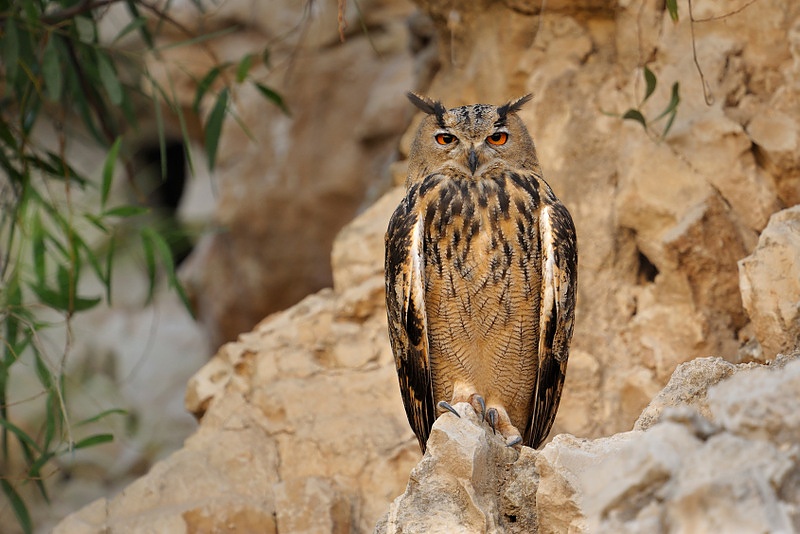Birds are one of the most attractive groups of animals in which there is an extraordinary diversity in plumage, characteristic singing and sounds, great mobility in the air environment and diverse habitats.
A large part of bird species, as a result of their food specialization, are the main group of vertebrates that have a "sanitary" role in forests. They are a natural regulating factor of many species of insects and rodents that cause great damage to forests and agricultural crops.
A total of 181 species of birds are found on the territory of the Nature park. Of these, 157 species are protected by the Biodiversity Act, and the number of species covered by the various international conservation conventions and directives protecting birds is 173. Of the orders that have the most species of high conservation importance, the most representative is the order Falconiformes (Falconiformes).

The area of the park is one of the most important and representative territories for Bulgaria in terms of rock-nesting (petrophilic) bird species. On the territory of the Natural Park "Vrachanski Balkan" there is an extremely wide variety of surface rock complexes. The area covers the altitude range from about 300 to 1400 m above sea level. Typical rock-loving species for the area are the raven (Corvus corax), white-breasted swift (Apus melba), rock swallow (Ptyonoprogne rupestris), red-throated swallow (Hirundo daurica), mountain buzzard (Alectoris graeca), owl (Bubo bubo), golden eagle (Aqila chrysaetos), the peregrine falcon (Falco peregrinus), the white-tailed buzzard (Buteo rufinus), the common buzzard (Pyrrhocorax graculus), the grebe (Tichodroma muraria), the black stork (Ciconia nigra) and the water blackbird (Cinclus cinclus), etc.
The other most widespread species are forest (dendrophilic) bird species, as well as birds inhabiting open areas with grassy vegetation.
Forest bird species are common in pure and mixed deciduous forests, conifer stands, riparian forests and heaths. The presence of natural hollows in some of the older trees create additional opportunities for cavity-nesting bird species. For the area of the park, these are the representatives of the Siniger family (Paridae). This also applies to the woodpecker (Sita europaea), the woodpecker (Certhia familiaris) and the wren (Jynx torquilla), which nest in various types of hollows, but unlike woodpeckers, they cannot dig them themselves. In the territory of the park, the representatives of the Passeriformes order are common species: red-throated passerine (Erithacus rubecula), blackbird (Turdus merula), blackbird (Turdus philomelos), mistletoe thrush (Turdus viscivorus), large black-headed warbler (Sylvia atricapilla), Spruce warbler (Phylloscopus collybita), common finch (Fringilla coelebs), periwinkle (Carduelis chloris), goldfinch (Carduelis carduelis), jay (Garulus glandarius), etc.

Species breeding in the forest habitats of the area are: common buzzard (Buteo buteo), forest buzzard (Strix aluco), grebe (Columba palumbus), common cuckoo (Cuculus canorus) and others.
Birds of the open grassy spaces are the field lark (Alauda arvensis), the rusty-breasted meadowlark (Saxicola rubetra), the quail (Coturnix coturnix), the meadow pipit (Crex crex). Significantly rarer species from this ecological group are the eared (Balkan) lark (Eremphila alpestris balcanica) and the mountain kidney (Anthus spinoletta), the black-breasted meadowlark (Saxicola torquata), the partridge (Perdix perdix) and others.
Open grasslands are an important foraging site for many species of birds that nest in other habitats (rocks, tree-shrub communities).

The large number of established waterfowl and waterfowl are only passing (flying) over the study area, during seasonal migrations and wintering, rarely during wanderings. Only on the periphery of the park are there nearby larger and constantly flowing rivers (Iskar, Cherna, Botunya), as well as several small never-drying natural karst lakes/swamps - the "puddles" around Beglichka Mogila peak.
Nesting aquatic bird species in the park are: black stork, blackbird, mountain wagtail (Motacilla cinerea) and white wagtail (Motacilla alba), the native kingfisher (Alcedo atthis). Along the left geographic bank of the Iskar River, the river plover (Charadrius dubius) and the short-winged cuckoo (Actitis chypoleucos) rarely (periodically) nest.
There is pronounced migration activity in the park area. The flyover "flow" is part of the migration route Via Aristotelis, which passes through the northwestern territories in the area of the Druzhev Saddle and the valley of the Cherna Reka River, as well as along the course of the Iskar River. In these areas, well-defined spring and autumn migration activity is observed in species from the Passeriformes order and to a lesser extent in some species from the Ciconiformes, Anseriformes, Charadriformes and Falconiformes orders. .


